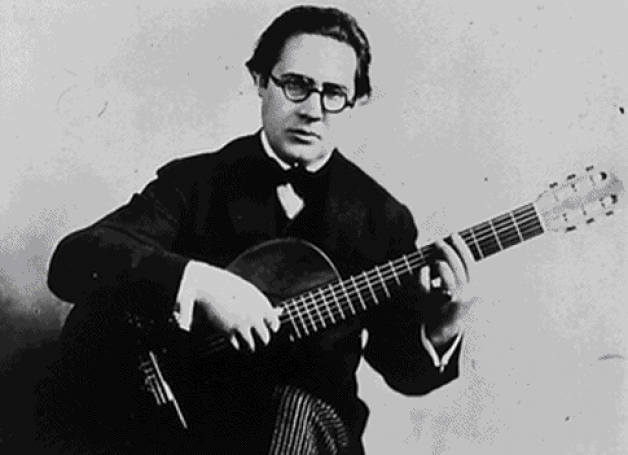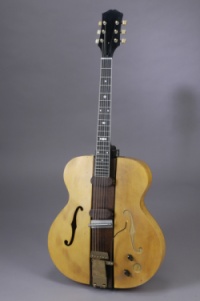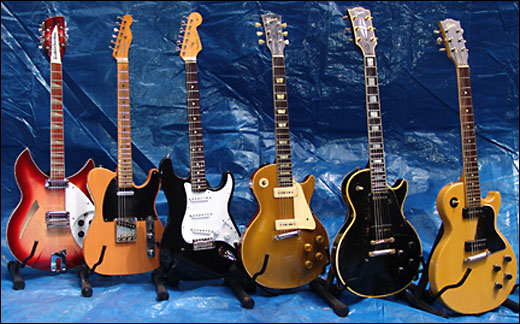By: Mike Oppenheim

Andres Segovia
This is the first in a series of articles detailing the spread of the guitar through a variety of musical and cultural contexts around the world.
A common cliché states that music is the universal language; while it’s not quite that simple, I do believe that music is a venue towards the universal communication that so many seek.
Due to its almost universal popularity, the guitar is an ideal candidate to facilitate the interactions needed to realize this goal.
There are already many guitarists, and other musicians, who have bridged cultures through musical interactions.
Some prime examples are Ry Cooder for his collaborations with the Buena Vista Social Club, Ali Farka Toure, and Vishwa Mohan Bhatt; John McLaughlin through his projects such as Shakti and the Mahavishnu Orchestra; and Banning Eyre’s time spent with the griots of Mali.
Important figures in expanding the guitar’s role in Western music include Andres Segovia, for carving out a niche and essentially creating a repertoire, for classical music, and Charlie Christian, for turning the guitar into a frontline instrument in jazz ensembles.
The preliminary columns for this series will touch on the instrument’s history, and the guitar in Hawaiian, African, and Flamenco contexts. Each article includes a brief history of the instrument in its geographical/cultural context, the effects of the native music on the guitar (and vice-versa), unique playing techniques and tunings, and CD/DVD and book reviews, where possible.
A precursor to this series and related article is “Indian Classical Guitar: An Introduction and Review of Two DVDs.”
What makes the guitar special?
This just begins to touch on where one can hear the guitar, but what does the guitar mean to the players and to the audience? A Martin D-28 in a bluegrass ensemble represents tradition, a Ramirez classical guitar is the height of sophistication, a Parker Fly is innovation, and the Fender Strat in a punk band is the symbol of youthful rebellion.
Jimi Hendrix burned his guitar, Kurt Cobain smashed his; conversely, Eric Clapton became a personality synonymous with his Strat “Blackie,” as did Steve Vai with the Ibanez Universe. Bob Dylan was criticized for playing an electric, while Michael Hedges was praised for his use of the harp guitar. Clearly, just as the guitar is found in nearly every genre of music, it also evokes emotions and meanings ranging from anger and rebellion to tradition and sophistication.

Les Paul’s “The Log” guitar.
It is the versatility of the guitar that has allowed it to cross between genres, generations, and geographic and cultural boundaries. The guitar may be acoustic, electric, or both, with steel, nylon, or gut strings. The body might be enormous and curvaceous, like the Gibson Super Jumbo, sleek and streamlined like the Gibson Chet Atkins SST, gothic and intimidating like the B.C. Rich Warlock, or merely a plank of wood like Les Paul’s revolutionary experiment “The Log.” The guitar might have six, seven, twelve, or more than twenty strings, yet all of these variations remain fundamentally the same instrument. Further, these strings may be tuned in any manner that pleases the player, encompassing open tunings, modal tunings, diatonic and chromatic tunings, and microtonal adjustments.
Finally, there is an endless number of ways to play the guitar, either fretted or fretless, played with the fingers or a pick, a violin bow or your teeth, a glass slide or a butter knife. And all of this comes in an instrument small enough to carry on your back or fit in the overhead bin on your flight to any destination in the world.
A Brief History of the Guitar
Many plucked chordophones were antecedents to the modern guitar, including the often cited oud and lute, both featuring elongated necks, frets, coursed (grouped) strings, and curved backs. The sixteenth century Spanish vihuela da mano is a more immediate predecessor to the modern guitar, often consisting of six courses of gut strings, an elongated neck of about ten frets, a flat back, and a general body shape similar to that of the modern guitar. Contemporary with the vihuela da mano were the early four- and five-course guitars.
The modern classical guitar was developed between the eighteenth and nineteenth centuries. A sixth course of strings was added before the courses were discontinued in favor of the modern practice of six single strings. By the late eighteenth century, movable frets were replaced with ivory, ebony, or wire frets set into the neck. The final steps in the evolution of the modern classical guitar were the development of fan bracing by Jose Pages, and the great increase to the overall size of the instrument by Antonio de Torres Jurado, around 1870.
Composers and guitarists including Francisco Tarrega, Dionysio Aguado, Fernando Sor, Ferdinando Carulli, Matteo Carcassi, and Mauro Giuliani championed the nineteenth century classical guitar. These composers remain significant in the repertoire and technique of classical guitar.
The 1920s saw the next major step in the evolution of the guitar. This time, the advent of the steel string guitar by Martin & Co. revolutionized the guitar as an ensemble instrument by greatly increasing the volume of the instrument. These early steel string guitars also diverged from the norms associated with the classical guitar by changing the shape and size of the body. The most influential shape developed in this period was the “D” model, or Martin Dreadnaught, one of the most imitated guitar designs in history. This period, from the 1920s to the mid-1930s, is known as the pre-war period, in which some of the most highly coveted guitars were crafted and manufactured by the Martin and Gibson companies.

Modern day electric guitars include guitars made by Rickenbacker, Fender and Gibson guitar companies.
The period between 1940 and 1960 brought about the full maturation and development of the solid body electric guitar. The most famous early example is “The Log,” designed by Les Paul, essentially consisting of a slab of pinewood with pickups and strings attached. By 1950, the Fender Telecaster was introduced, followed in 1952 by the Gibson Les Paul.
Of course, many other variations on the guitar were introduced throughout this history. These include archtop guitars, semi-hollow and hollow body acoustics, the flamenco guitar, twelve-string guitars, seven-string guitars, the advent of tremelo systems, and many more innovations.
The sheer variety of guitar designs is indicative of the broad range of musical scenarios suited for the guitar. Throughout its history, the guitar has constantly evolved, moving into existing musical niches, and even creating new ones. Given its history, it is only appropriate that the guitar continues to expand its range across the globe.
Videos:
ANDRES SEGOVIA
CHET ATKINS & JERRY REED
JIMI HENDRIX
Suggested Reading and Listening
This is a very subjective list of recommendations, drawing from a pool of 400 years of guitar music. Obviously, the list could go forever, but here are a few of the books and recordings that helped and inspired me along the way.
General Reading:
Guitar: An American Life, by Tim Brookes, 2006.
The Guitar Handbook, by Ralph Denyer, 1992.
Martin Guitars: An Illustrated Celebration of America’s Premier Guitarmaker, by Jim Washburn, 1999
Sheet Music and Instructional Books/DVDs:
Chet Atkins in Three Dimensions, Volume 1: 50 Years of Legendary Guitar, by Chet Atkins, Deyan Bratik, and John McClellan, 2003.
The Classic Guitar Collection, Volume 1, by Harvey Vinson, 1992.
Fingerstyle Blues Songbook, by Steve James, 2005.
The Guitar of Mississippi John Hurt, Volume 1, (DVD) by John Miller, 2002.
The Library of Guitar Classics, by Jerry Willard, 1998.
Recordings and DVDs:
Almost Alone, by Chet Atkins, 1996.
The Johnny Cash TV Show: The Best of Johnny Cash 1969-1971, (DVD) by Johnny Cash, 2007.
Layla and Other Assorted Love Songs, by Derek and the Dominos, 1970.
The Best of Mississippi John Hurt, by Mississippi John Hurt, 1990.
Six and Twelve String Guitar, by Leo Kottke, 1996.
Second Winter, by Johnny Winter, 1969.
About Mike Oppenheim – Multi-instrumentalist, Mike Oppenheim, lives in Thailand, and plays guitar, banjo, mandolin and Mohan Veena (Indian Classical Guitar). While earning his degree in music at Kenyon College, he joined the Indonesian Gamelan ensemble. He interned for the Calliope Society of Folk Music in Pittsburgh, Pennsylvania. Mike also apprenticed in guitar building under luthier, Bob Zatzman. He moved to Canada to earn a masters degree in Ethnomusicology at the University of British Columbia, where he performed with the UBC African Drum and Dance Ensemble and the UBC Capoeira Angola group. Mike teaches on-line guitar lessons and can be reached at: mikeopmusicATgmail.com or through his website: Mike Oppenheim Music.
Guitar In World Music Article at Guitar International Magazine | Mike Oppenheim (11 years ago)
[…] A new article of mine is available at Guitar International Magazine’s website. This is the first in a series of articles about the guitar in world music cultures entitled ”Going Places with the Guitar: World Music.” […]